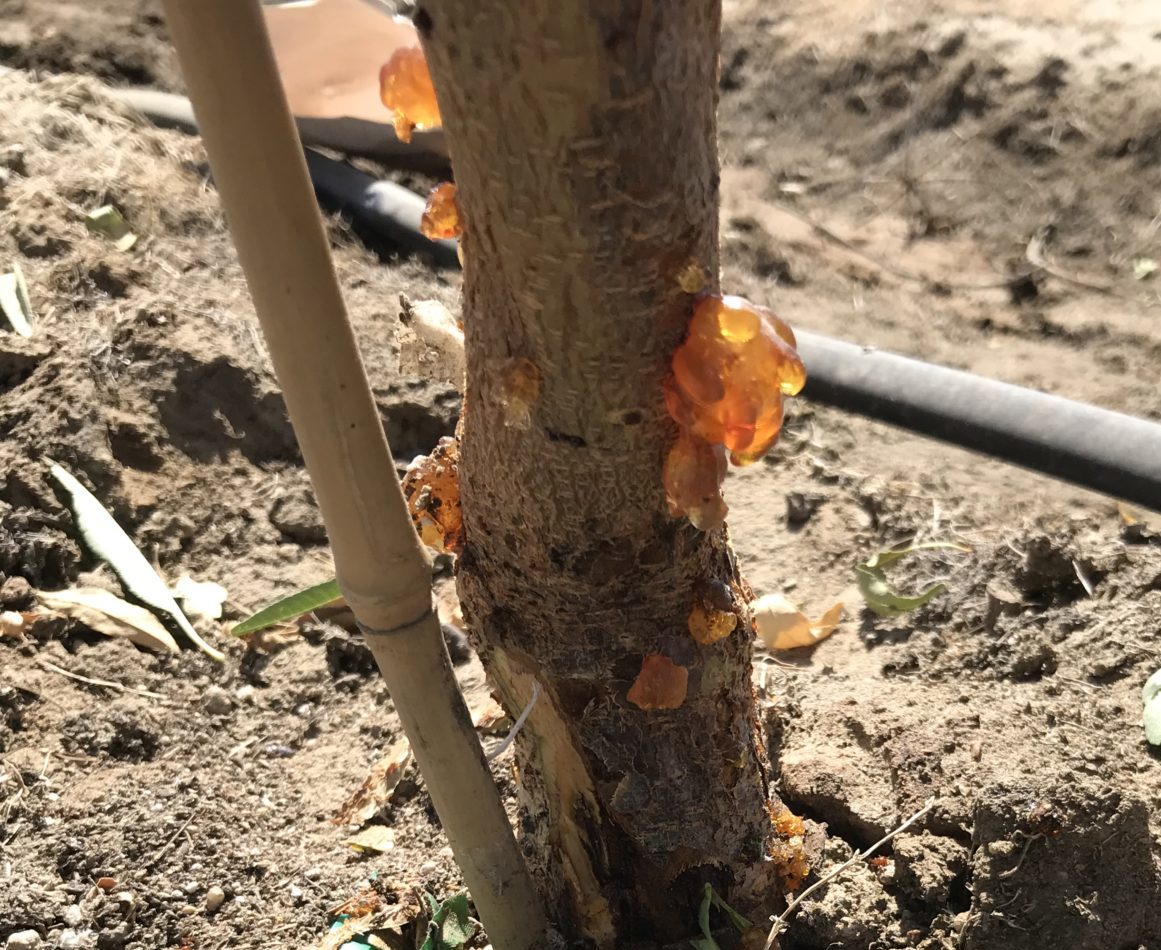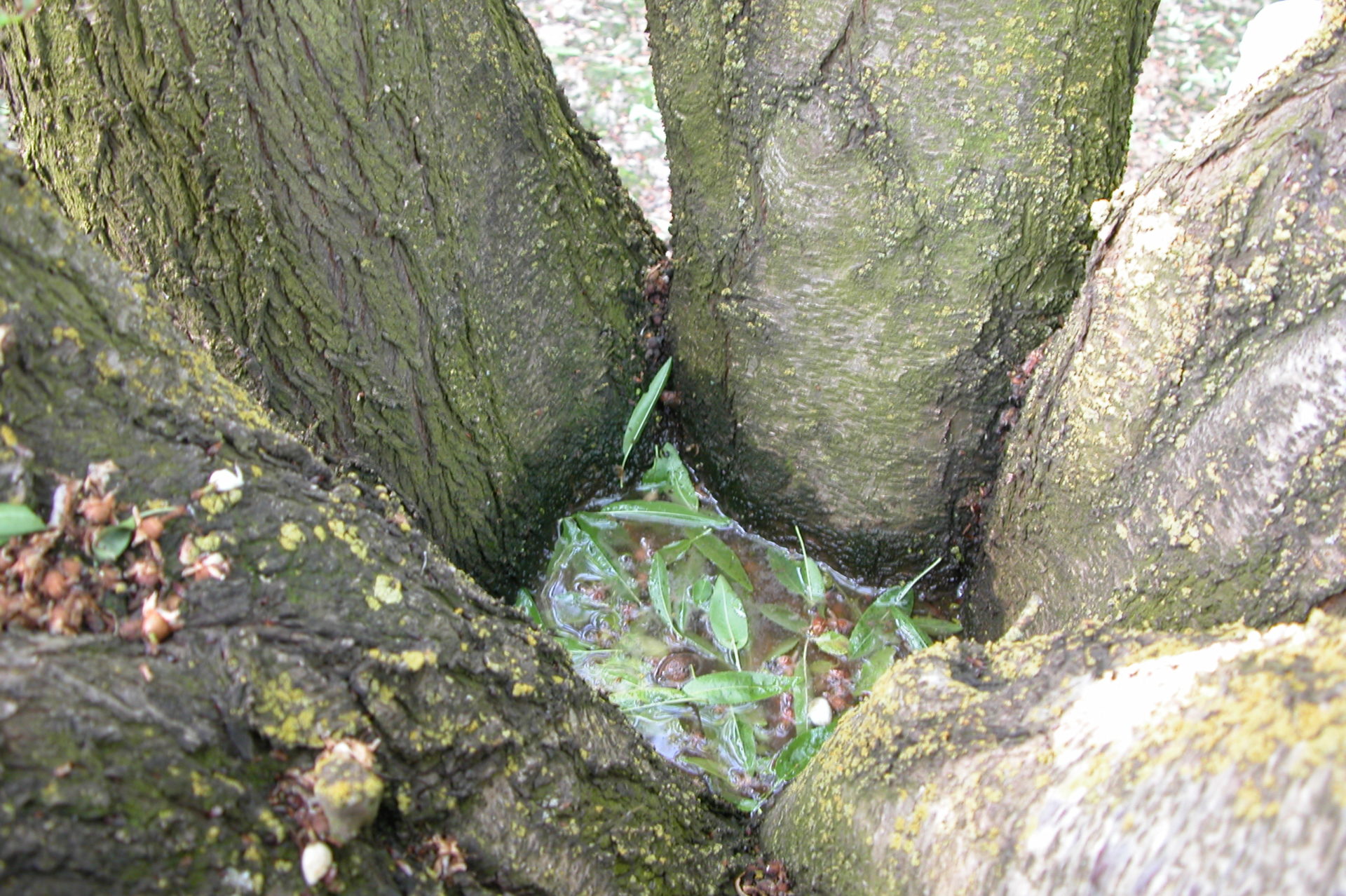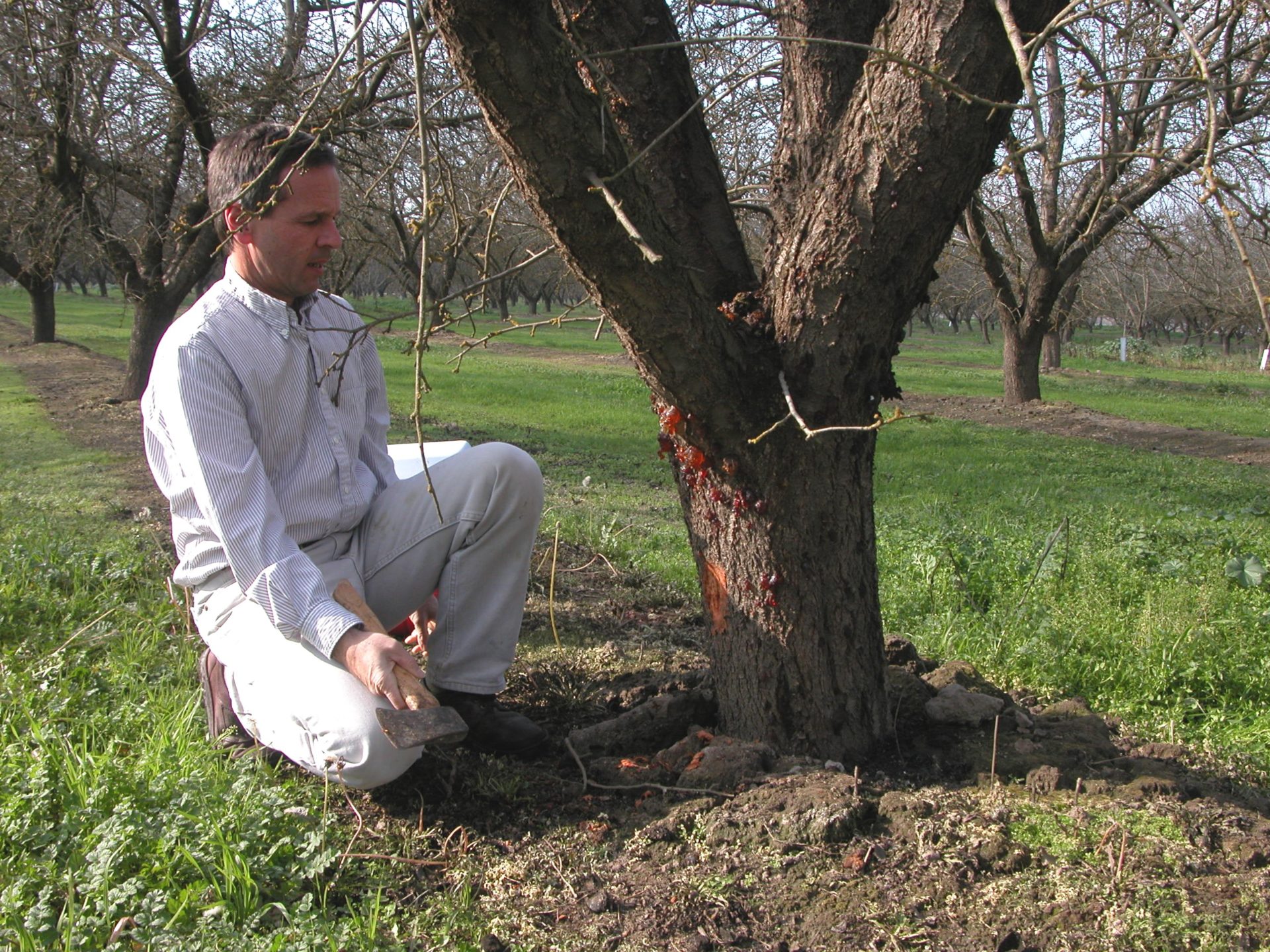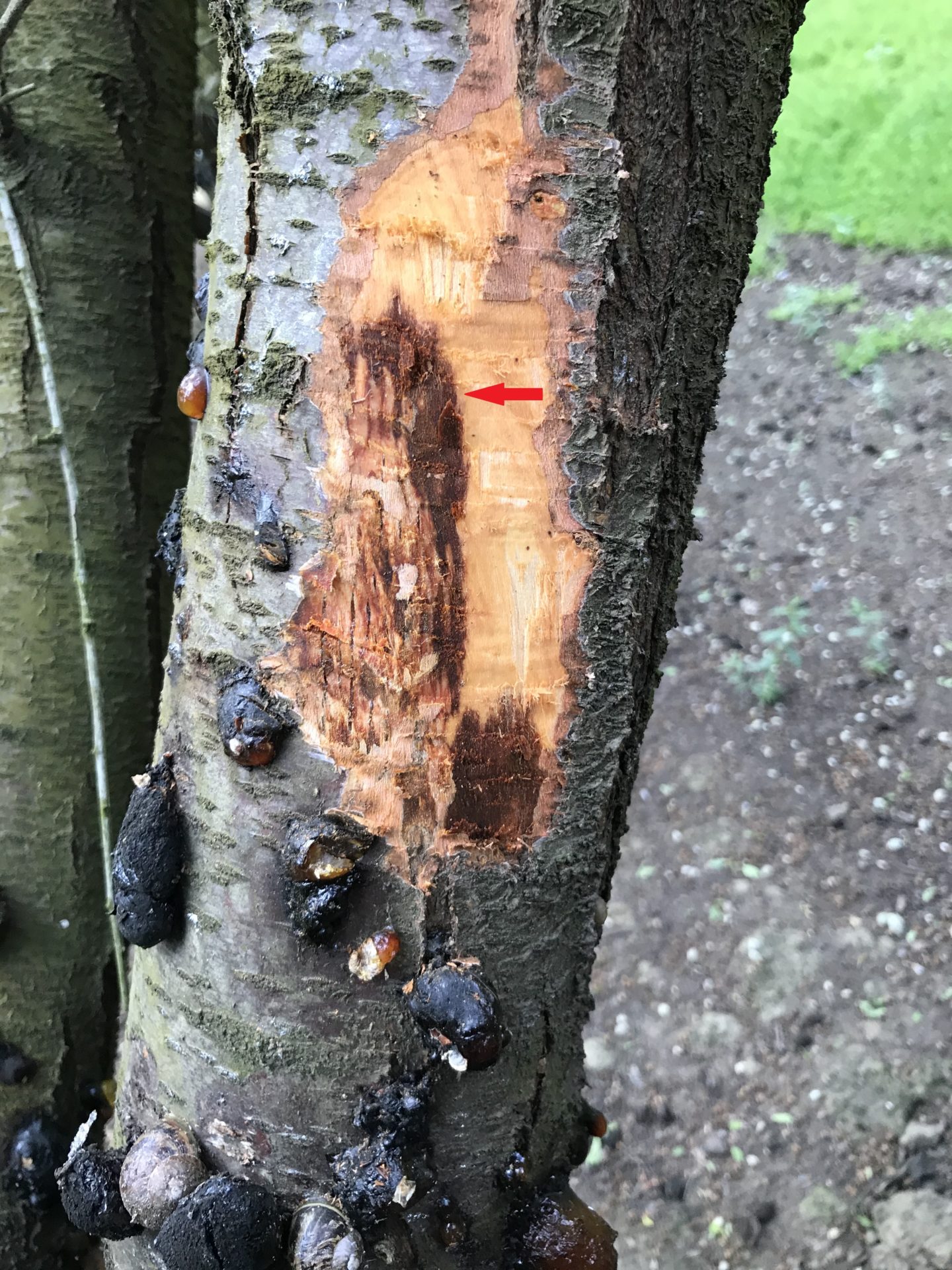
Many species of Phytophthora continue to cause serious losses in California almond orchards. Collectively, these pathogens affect almond trees of all ages, causing decline and death in young orchards in their first few years of development as well as in bearing and fully mature orchards in their prime. We tend to name diseases caused by Phytophthora with reference to the tree parts most obviously affected, for example, Phytophthora species cause “root rot,” “crown rot,” “trunk and scaffold cankers,” and “pruning wound cankers.” At least 10 different species of Phytophthora are known to infect almonds, varying in tree parts they attack and general aggressiveness.
Phytophthora spp. belong to a group of organisms sometimes referred to as oomycetes or “water molds” because they thrive in wet conditions and have an unusual cell wall composition including cellulose. As such, they differ from typical plant pathogenic fungi, such as pathogens that belong to the Botryosphaeriaceae family, and are not controlled by chemicals that target true fungi. In periods of wetness, all Phytophthora spp. can produce and release infective, swimming zoospores. In dry periods, Phytophthora species can persist in thick-walled spores indefinitely. Soil fumigation can reduce but will not eliminate populations of Phytophthora. Wounds may facilitate but are not necessary for infection by Phytophthora.
In California almonds overall, Phytophthora species are probably best known as root and crown pathogens (See Figure 1). They are soilborne, yet many of them can also occur and move in surface water sources, such as rivers, canals, and storage reservoirs. Phytophthora can also be distributed on seemingly symptomless planting stock. Periods of soil water saturation, especially around the root crown, favor reproduction and infection by Phytophthora. In recent years, Kern County, as well as in counties to the north, many farm calls have involved Phytophthora crown and root rot of newly planted almond orchards up to a few years of age.

Despite their recognition as soilborne pathogens, Phytophthora species can also infect almond trees above ground. In the late 1990s and early 2000s, for example, a malady we described as Perennial Phytophthora Canker (PPC) caused high incidences of tree loss in many previously high-yielding almond orchards in the southern San Joaquin Valley. On a high percentage of the trees, the cankers were limited to above ground tree parts. Following intense late-spring rains in 2019, we observed a resurgence of PPC in several Kern County almond orchards (See Figure 2). Unfortunately, these orchards were entering, or had reached, their prime producing years, and incidences of tree loss were unacceptably high, involving up to several thousand trees.

Additional Insights on Perennial Phytophthora Canker (PPC)
Because of its recent resurgence in Kern County, and its sporadic, lesser-known nature compared to that of Phytophthora crown and root rots, we offer additional insights on PPC of almond. As mentioned, it affects mature trees that typically have been bearing for several to many years. The most common site of the aerial infections is in “pockets” that naturally form where several scaffold branches join the trunk in close proximity (See Figure 3). Less commonly, infections are centered near joints of two scaffold branches. At the pocket and branch junctures, “growth cracks” can form in the bark due to opposing pressure. The pockets and other rough tree surfaces tend to collect debris (e.g., leaves, soil, twigs) from the orchard floor at harvest. Our previous research demonstrated that the debris can contain inoculum of Phytophthora, including P. citricola, the main species associated with PPC. In winter or spring months, it is likely that extended heavy periods of rain favor Phytophthora infections in the pockets and at branch junctures. As mentioned earlier, the free water stimulates Phytophthora species to produce and disperse infective zoospores.

To a lesser extent, we have also observed PPC developing from the root and the crown area and moving up the main trunk into tree scaffolds. In our previous surveys with Farm Advisor Mario Viveros (retired UCCE), P. citricola was the predominant species causing PPC cankers of aerial origin, while P. cactorum was associated with cankers that developed below the soil or at the crown region. Our recent Kern County surveys suggested similar associations between these Phytophthora species and infection sites in 2019.
PPC, whether originating from a pocket, trunk or root crown infection, will exhibit profuse gumming, which is yellow to amber in color. Removing the bark will show the development of a perennial canker that can expand rapidly over time leading to main scaffolds decline (See Figure 4). However, the symptoms can be confused with those caused by other pathogens, especially fungi. So, it is important to conduct lab tests to confirm whether a Phytophthora sp. is involved and thereby reach a solid position from which to select appropriate management practices. We also observed that some of the infected trees with Phytophthora will express early defoliation in the fall, compared to healthy trees. In many cases, trees infected with Phytophthora also developed Foamy canker, which is, in this case, a secondary issue and is not the main cause of tree decline and mortality (See Figure 5).

The best time to isolate and diagnose the disease caused by Phytophthora is when the cankers are active and expanding. In Kern County, we isolated the pathogen as early as mid-January to April and later in the season when the cankers were active and fresh gumming was exuded from the trunk and main scaffolds. Optimal samples are collected by exposing the edges of the cankers, as characterized by brown necrotic tissue bounded by healthy white tissue (See Figure 4). Samples should be collected to contain the margin of the canker where the pathogen is actively growing. The samples are kept cool but not frozen and sent to a lab for isolation and identification using traditional or molecular methods. Once we have positively identified Phytophthora spp. as the causal agent(s), we are in a good position to implement cultural and chemical control methods to manage the disease on already infected trees and prevent its spread to other healthy trees.
It is important to note that though PPC has expressed its highest incidence in Kern County, it has occurred in most other almond growing regions in California’s Central Valley.

Cultural and Genetic Management of Phytophthora
For PPC management, proper main scaffold selection during the early stages of tree training is a very important first step. Scaffolds should be selected to space them apart vertically on the tree trunk to reduce the incidence of pocket formation in the crotch area where all the infested debris and water from rain may collect. This practice will also help in reducing the incidence of other types of cankers caused by fungi such as Botryosphaeria cankers.
For both Phytophthora crown and root rots and PPC, several early orchard design decisions can profoundly impact management of Phytophthora, for example: rootstock choice, land preparation and drainage, irrigation system design and operation, and timing and depth of tree planting are all important. Rootstocks need to be chosen for best general environmental adaptation to the soil environment, but growers need to be aware that peach-almond hybrids (e.g. Hansen 536) are relatively susceptible to Phytophthora root and crown rots, at least in their first few years after planting. Regardless of rootstock, it is important to leave the graft union above the ground at planting and avoid covering it with soil as the almond scion is very susceptible to Phytophthora spp. Growers should typically avoid planting trees in very late spring or summer (i.e., as is sometimes done for potted trees on dual drip lines) because this schedule can set a grower up for a Phytophthora challenge; out of necessity, to meet the critical watering demands of the undeveloped root systems, the drip lines are placed “on” the root crown, where water saturation can lead to infection by Phytophthora. Additional “tried-and-true” cultural practices to control Phytophthora crown and root rots include planting on berms and resolving water infiltration problems.
Although all scion varieties of almond are highly susceptible to Phytophthora, marked differences in genetic resistance are known among almond rootstocks. Generally, peach-almond hybrids are more susceptible to Phytophthora than peach rootstocks, while some plum hybrid rootstocks can offer an additional increment of resistance to some species of Phytophthora, compared to peach. The Almond Board of California is supporting long-term research to develop rootstocks with improved resistance to Phytophthora and other soilborne pathogens. We are monitoring the prevalence and aggressiveness of different Phytophthora species on almond to ensure that our rootstock screens for resistance adequately represent Phytophthora challenges in orchards.
Chemical Management of Phytophthora
Systemic oomycete “fungicides”, including mefenoxam and phosphites, have been used for control of Phytophthora crown and root rots. In addition, we are cooperating with Dr. Jim Adaskaveg (UC Riverside) in an Almond Board-funded project to test new oomycete fungicides that show promise for almond industry use.
For control of PPC, previous Almond Board-funded research in Kern County showed efficacy of phosphite products. Best results were obtained from foliar applications during summer or fall, before leaf senescence, though spring chemigation resulted in a less-consistent benefit. Phosphites move systematically from source to sink inside the tree and can suppress cankers and infection for up to five months after effective application.
As we have suggested, staying ahead of problems with Phytophthora can require judicious orchard design and planning; timely, precise execution of orchard tasks; early awareness of potential Phytophthora problems as indicated by visual orchard scouting; and accurate diagnosis of Phytophthora diseases as supported by lab confirmation. Even after planting, early identification of a Phytophthora problem can facilitate integrated and timely corrective actions that will help to avoid further loss, such as soil water management adjustments and the use of protective chemicals, etc. It is expected that continued teamwork among growers, advisors, and researchers will facilitate additional improvements in cultural, genetic, and chemical control strategies for Phytophthora on almond.
Sources:
1. Browne, G. T., Viveros, M. A. 2005. Lethal Cankers Caused by Phytophthora spp. in Almond Scions: Specific Etiology and Potential Inoculum Sources. Plant Disease 83:739-745.
2. Browne, G. T., Viveros, M. A. 1999. Effects of Phosphonate and Mefenoxam Treatments on Development of Perennial Cankers Caused by Two Phytophthora spp. on Almond. Plant Disease 89:241-249.










